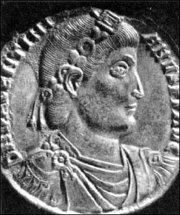Valentinian I
|
|
Valentinian I (321 - November 17, 375) was a Roman emperor of the Western Roman Empire (364 - 375). He was born at Cibalis, in Pannonia, the son of a successful general, Gratian the Elder.
He had been an officer of the guard under Julian and Jovian, and had risen high in the imperial service. Of robust frame and distinguished appearance, he possessed great courage and military capacity. He was chosen emperor in his forty-third year by the officers of the army at Nicaea in Bithynia on February 28, 364, and shortly afterwards named his brother Valens colleague with him in the empire.
The two brothers, after passing through the chief cities of the neighbouring district, arranged the partition of the empire at Naissus (Nissa) in Upper Moesia. As Western Roman Emperor, Valentinian took Italy, Illyricum, Spain, the Gauls, Britain and Africa, leaving to Eastern Roman Emperor Valens the eastern half of the Balkan peninsula, Greece, Egypt, Syria and Asia Minor as far as Persia. They were immediately confronted by the revolt of Procopius, a relative of the deceased Julian. Valens managed to defeat his army at Thyatria in Lydia in 366, and Procopius was executed shortly afterwards.
During the short reign of Valentinian there were wars in Africa, in Germany and in Britain, and Rome came into collision with barbarian peoples never heard before. Specifically the Burgundians, the Saxons and the Alamanni.
Valentinian's chief work was guarding the frontiers and establishing military positions. Milan was at first his headquarters for settling the affairs of northern Italy.The following year (365) Valentinian was at Paris, and then at Reims, to direct the operations of his generals against the Alamanni.
This people, defeated at Scarpona (Charpeigne) and Catelauni (Châlons-en-Champagne) by Jovinus, were driven back to the German bank of the Rhine, and checked for a while by a chain of military posts and fortresses. At the close of 367, however, they suddenly crossed the Rhine, attacked Moguntiacum (Mainz) and plundered the city. Valentinian attacked them at Solicinium (Sulz am Neckar, in the Neckar valley, or Schwetzingen) with a large army, and defeated them with great slaughter. But his own losses were so considerable that Valentinian abandoned the idea of following up his success.
Later, in 374, Valentinian made peace with their king, Macrianus, who from that time remained a true friend of the Romans. The next three years he spent at Trier, which he chiefly made his headquarters, organizing the defence of the Rhine frontier, and personally superintending the construction of numerous forts.
During his reign the coasts of Gaul were harassed by the Saxon pirates, with whom the Picts and Scots of northern Britain joined hands, and ravaged the island from the Antonine Wall to the shores of Kent. In 368 Count Theodosius was sent to drive back the invaders; in this he was completely successful, and established a new British province, called Valentia, in honour of the emperor.
In Africa, Firmus, raised the standard of revolt, being joined by the provincials, who had been rendered desperate by the cruelty and extortions of Count Romanus, the military governor. The services of Theodosius were again requisitioned. He landed in Africa with a small band of veterans, and Firmus, to avoid being taken prisoner, committed suicide.
Solidus_Valens.jpg
In 374 the Quadi, a Germanic tribe in what is now Moravia and Slovakia, resenting the erection of Roman forts to the north of the Danube in what they considered to be their own territory, and further exasperated by the treacherous murder of their king, Gabinius, crossed the river and laid waste the province of Pannonia. The emperor in April, 375 entered Illyricum with a powerful army. But during an audience to an embassy from the Quadi at Brigetio on the Danube (near Komárom, Hungary), Valentinian suffered a burst blood vessel in the skull while angrily yelling at the people gathered. This injury resulted in his death on November 17, 375.
His general administration seems to have been thoroughly honest and able, in some respects beneficent. If Valentinian was hard and exacting in the matter of taxes, he spent them in the defence and improvement of his dominions, not in idle show or luxury. Though himself a plain and almost illiterate soldier, Valentinian was a founder of schools. He also provided medical attendance for the poor of Rome, by appointing a physician for each of the fourteen districts of the city.
Valentinian was an Orthodox Christian but permitted absolute religious freedom to all his subjects. Against all abuses, both civil and ecclesiastical, Valentinian steadily set his face, even against the increasing wealth and worldliness of the clergy. His chief flaw was his temper, which at times was frightful, and showed itself in its full fierceness in the punishment of persons accused of witchcraft, fortune-telling or magical practices.
Reference
- This entry incorporates material from the 1911 Encyclopedia Britannica.
| Preceded by: Jovian | Roman Emperor 364–375 with Valens | Succeeded by: Valens</b>, Gratian and Valentinian II Template:End boxde:Valentinian I. fr:Valentinien Ier pl:Walentynian I |

